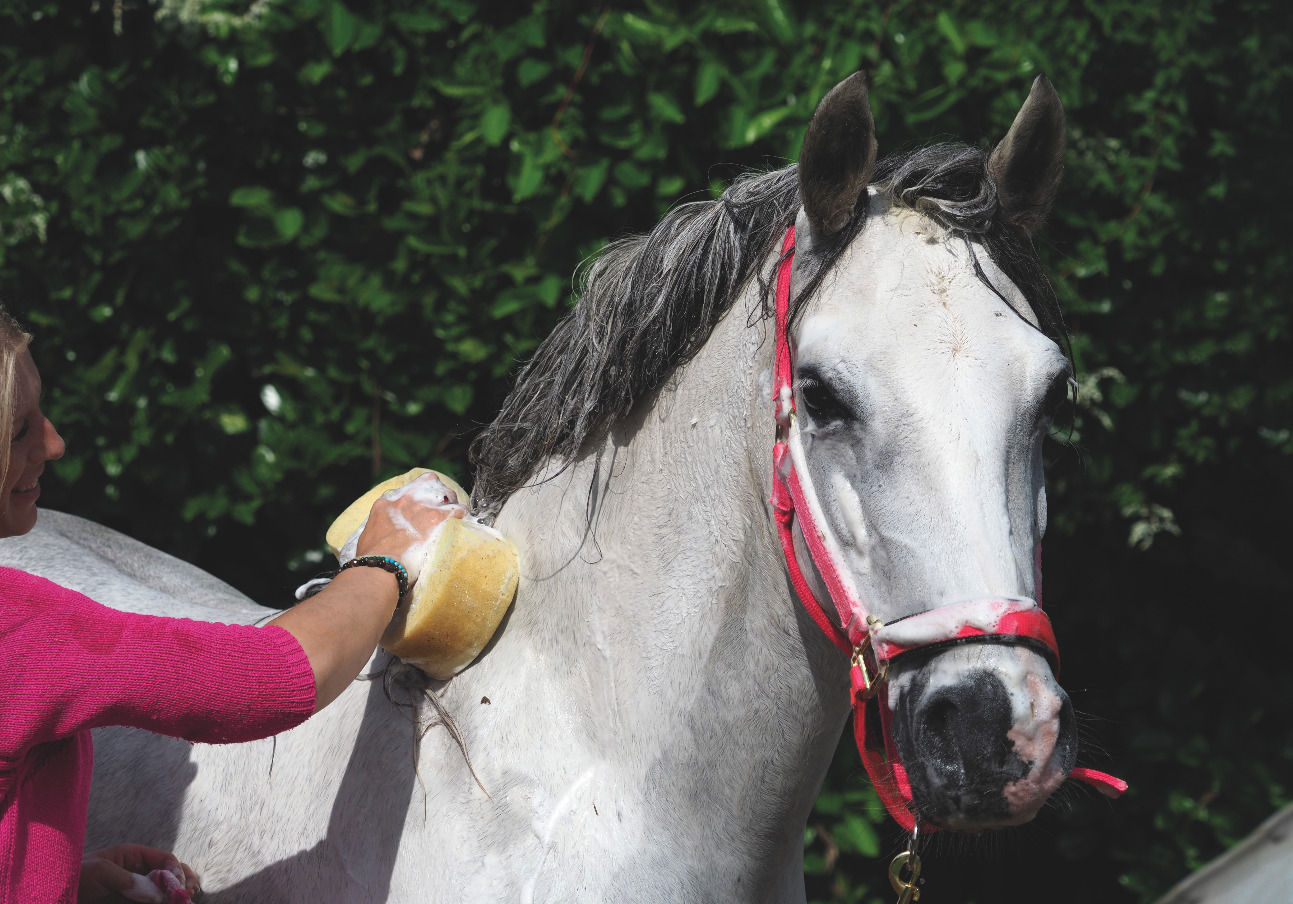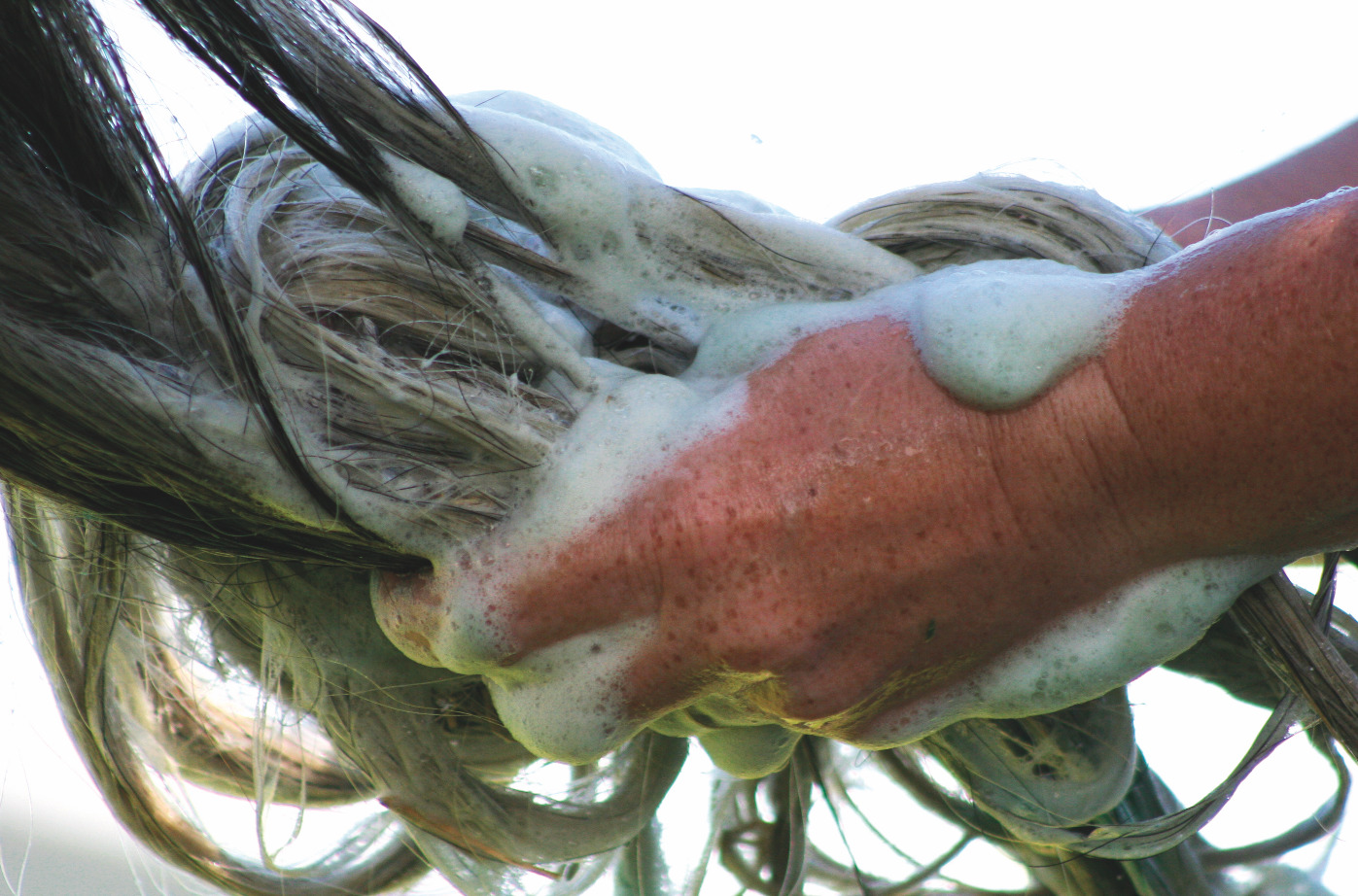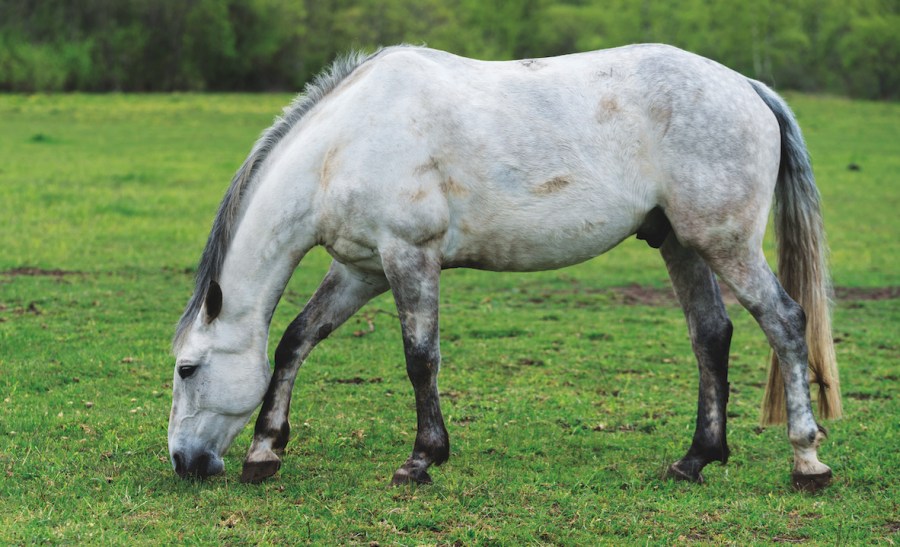Stubborn brown stable stains, green grass patches and tails with a yellow tinge. If you own a grey or coloured, this probably sounds familiar. Vicky Goody from Smart Grooming explains how to return your horse to their gleaming whiteness.
Stubborn stains
Some stains from the field or stable are more stubborn than others to remove, but the secret to success is to attend to them as soon as they appear. The longer they are left, the harder it will be.
Stable stains
-
- Use warm water on all stained areas in preference to cold. The warmer the temperature the easier it is to lift the stain out.

It’s easier to lift stains using warm water rather than cold
- Dampen the stained area thoroughly with a sponge or spray directly from a hose pipe (but bear in mind the latter water will be cold).
- Apply a stain removal spray and massage in well with a massage pad or firm bristled brush. This part is essential and will help to loosen the dirt. Leave for a few moments before rinsing off.
- For stubborn stains, or before a show or competition, shampoo and massage the area well before the final rinse.
Grass stains
These can be tricky, but again if dealt with promptly, they will come off more easily. Apply the same method as above in the first instance.
- On hocks and other areas, where grass stains can be deep seated and there may still be a slight colour discolouration, a chalk-based whitener will disguise it. This is something that you only need to do for competition or show purposes.
- A whitener can be applied by dipping a damp sponge into the powder or by mixing a small amount of powder and water in a pot and painting on with a brush. In both cases, allow to dry before brushing off any residual powder.
Yellow manes and tails

The longer a tail is unwashed, the harder it is to get back to its whiteness
This is a problem that we are frequently asked about. The answer is that it really depends on how long the urine has been left in the tail. The longer it has been unwashed, the harder it will be to get it back to its original whiteness.
With mares in particular, urine can stain the tail more easily, and if left for a long period will absorb into the hair follicle, creating a more permanent stain. However, if washed once a week and conditioned after, this will limit the urine from causing the hair to discolour.
To regain original whiteness may take anything from just one good wash to many weeks or months of regular washing and conditioning, so be patient.
How to do it:
- Immerse the tail in a bucket of warm water and allow to soak for three to four minutes to allow the hair to really absorb the water. Soak the mane thoroughly with warm water too.
- We find a spray-in stain remover is helpful at this stage, particularly if dealing with a lot of colour discolouration. Apply to the tail and/or mane and massage in well. Leave for three to four minutes to let the product soak in before rinsing.
- Apply a whitening shampoo. These are made specifically for whitening and brightening and use a colouring to help negate the yellow of the stain and bring out the white. Rub in well before rinsing and repeating, using warm water.
- The next stage is to make up a blue powder rinse. The technique of “blueing”, as it is called, will enhance the whiteness of any white hair and can be used for manes, tails and all over the body.
- Follow the instructions using a small amount of blue powder mixed in a bucket of water. Soak the mane and tail for a few seconds, giving a final rinse in warm, clear water.
- Last, apply a mane and tail conditioning lotion. This will provide a barrier against the urine in between the weekly washes. Apply the lotion two or three times a week to ensure no further staining penetrates the hair.
- Repeat this washing and whitening procedure each day for the first week for stubborn staining.
Fetlocks
Keeping thick feathers white and clean takes a huge amount of time and care. But keeping feather hair well looked after will ensure the skin underneath is cared for too. When conditions are wet and muddy, it creates a haven for bacteria under thick feather hair and can cause sore and cracked skin.
Daily care and maintenance as part of a grooming routine will ensure skin problems will be noticed, so it’s crucial to make feather care a daily part of your routine.
- Applying a good quality barrier oil such as pig oil will help to provide protection against wet and mud and enable feathers to be brushed through more easily. The addition of flowers of sulphur can also help to keep feather mites at bay.
- Keep on top of any stains and remove them daily. Stains that are left will be much harder to remove. Invest in a good quality stain remover and purple shampoo to help lift the stains and prevent new ones.
- After washing it’s quick and easy to dry feathers by using an old-fashioned method involving wood flour. Fluff the flour into the feathers; this will add volume as well as aid the drying process and help keep the skin healthy.
- For added whiteness, especially on show days, use a fine mineral-based whitening powder after applying wood flour. Apply directly to the feathers and work into the hair, brushing out afterwards.
- This will also aid drying and give additional whiteness and volume. The whitening powder can also be mixed with water and painted on to the leg. Less is more when applying in a wet format.
- Finish by applying a spray-on conditioner. This will protect the hair as well as making it easier to brush through and will provide a barrier against dirt and staining.
4 golden rules
- Patch test first: With greys, and especially those with pink skin, be careful when introducing new products. Some products can irritate when used on a regular basis.
- Avoid using household items: There is plenty of tempting but potentially ineffective and harmful advice and tips from other horse owners suggesting the use of household cleaning products to achieve whitening results.
- Use good-quality brushes: Certain bristles will work better at getting to grips with mud and dirt, but you will need the softer ones for finishing off and flicking out remaining dust and dander.
- Keep on top of it: Start a weekly wash routine and attend to stains as soon as they appear. The sooner you take action the less you will need to do in the long run.










